Endocannabinoid Signaling at Hypothalamic Steroidogenic Factor-1/Proopiomelanocortin Synapses Is Sex- and Diet-Sensitive
- PMID: 29973869
- PMCID: PMC6020785
- DOI: 10.3389/fnmol.2018.00214
Endocannabinoid Signaling at Hypothalamic Steroidogenic Factor-1/Proopiomelanocortin Synapses Is Sex- and Diet-Sensitive
Abstract
We tested the hypotheses that steroidogenic factor (SF)-1 neurons in the hypothalamic ventromedial nucleus (VMN) provide sexually disparate, endocannabinoid (EC)- and diet-sensitive glutamatergic input onto proopiomelanocortin (POMC) neurons. Electrophysiological recordings were performed in hypothalamic slices from intact and castrated guinea pigs, along with in vitro optogenetic experiments in intact male as well as cycling and ovariectomized female NR5A1-Cre mice. In slices from castrated male and female guinea pigs, depolarized-induced suppression of excitation (DSE) time-dependently reduced the amplitude of evoked excitatory postsynaptic currents (eEPSCs) in POMC neurons generated by electrically stimulating the dorsomedial VMN. Androgen stimulation rapidly enhanced this DSE, which was also found in insulin-resistant, high-fat diet (HFD)-fed males. By contrast, retrograde signaling at VMN/ARC POMC synapses was markedly attenuated in periovulatory females. HFD potentiated central cannabinoid-induced hyperphagia in both males and females, but exerted differential influences on cannabinoid-induced increases in energy expenditure. In NR5A1-Cre mice, the reduction in light-evoked EPSC amplitude caused by postsynaptic depolarization in cycling females was modest in comparison to that seen in intact males. Estradiol attenuated the DSE in light-evoked EPSC amplitude in slices from ovariectomized females. Moreover, the retrograde inhibition of transmission was further accentuated in HFD-fed males. Chemogenetic activation of SF-1 neurons suppressed appetite and increased energy expenditure in males, effects which were attenuated by HFD. Conversely, energy expenditure was increased in estradiol- but not vehicle-treated ovariectomized females. Together with our previous studies indicating that DSE in POMC neurons is EC-mediated, these findings indicate that VMN SF-1/ARC POMC synapses represent a sexually differentiated, EC- and diet-sensitive anorexigenic component within the hypothalamic energy balance circuitry.
Keywords: endocannabinoids; estradiol; insulin; obesity; proopiomelanocortin; sex differences; steroidogenic factor-1; testosterone.
Figures


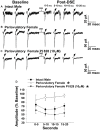

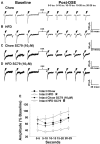

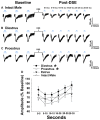
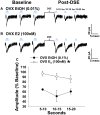
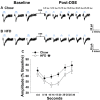




Similar articles
-
Nociceptin/orphanin FQ modulates energy homeostasis through inhibition of neurotransmission at VMN SF-1/ARC POMC synapses in a sex- and diet-dependent manner.Biol Sex Differ. 2019 Feb 12;10(1):9. doi: 10.1186/s13293-019-0220-3. Biol Sex Differ. 2019. PMID: 30755252 Free PMC article.
-
Pituitary Adenylate Cyclase-Activating Polypeptide Excites Proopiomelanocortin Neurons: Implications for the Regulation of Energy Homeostasis.Neuroendocrinology. 2021;111(1-2):45-69. doi: 10.1159/000506367. Epub 2020 Feb 7. Neuroendocrinology. 2021. PMID: 32028278
-
Testosterone Rapidly Augments Retrograde Endocannabinoid Signaling in Proopiomelanocortin Neurons to Suppress Glutamatergic Input from Steroidogenic Factor 1 Neurons via Upregulation of Diacylglycerol Lipase-α.Neuroendocrinology. 2017;105(4):341-356. doi: 10.1159/000453370. Epub 2016 Nov 21. Neuroendocrinology. 2017. PMID: 27871072 Free PMC article.
-
Modulatory influences of estradiol and other anorexigenic hormones on metabotropic, Gi/o-coupled receptor function in the hypothalamic control of energy homeostasis.J Steroid Biochem Mol Biol. 2016 Jun;160:15-26. doi: 10.1016/j.jsbmb.2015.07.014. Epub 2015 Jul 29. J Steroid Biochem Mol Biol. 2016. PMID: 26232394 Free PMC article. Review.
-
Sex differences in the cannabinoid regulation of energy homeostasis.Psychoneuroendocrinology. 2009 Dec;34 Suppl 1(0 1):S237-46. doi: 10.1016/j.psyneuen.2009.04.007. Psychoneuroendocrinology. 2009. PMID: 19427130 Free PMC article. Review.
Cited by
-
The role of pituitary adenylate cyclase-activating polypeptide neurons in the hypothalamic ventromedial nucleus and the cognate PAC1 receptor in the regulation of hedonic feeding.Front Nutr. 2024 Aug 21;11:1437526. doi: 10.3389/fnut.2024.1437526. eCollection 2024. Front Nutr. 2024. PMID: 39234295 Free PMC article.
-
CPT1C deficiency in SF1 neurons impairs early metabolic adaptation to dietary fats, leading to obesity.Mol Metab. 2025 Jun;96:102155. doi: 10.1016/j.molmet.2025.102155. Epub 2025 Apr 21. Mol Metab. 2025. PMID: 40268191 Free PMC article.
-
Role of Nociceptin/Orphanin FQ-NOP Receptor System in the Regulation of Stress-Related Disorders.Int J Mol Sci. 2021 Nov 30;22(23):12956. doi: 10.3390/ijms222312956. Int J Mol Sci. 2021. PMID: 34884757 Free PMC article. Review.
-
CB1Rs in VMH neurons regulate glucose homeostasis but not body weight.Am J Physiol Endocrinol Metab. 2021 Jul 1;321(1):E146-E155. doi: 10.1152/ajpendo.00044.2021. Epub 2021 Jun 7. Am J Physiol Endocrinol Metab. 2021. PMID: 34097543 Free PMC article.
-
Mediobasal hypothalamic neurons contribute to the control of brown adipose tissue sympathetic nerve activity and cutaneous vasoconstriction.J Therm Biol. 2023 May;114:103551. doi: 10.1016/j.jtherbio.2023.103551. Epub 2023 May 11. J Therm Biol. 2023. PMID: 37216765 Free PMC article.
References
-
- Andrews W. W., Advis J. P., Ojeda S. R. (1981). The maturation of estradiol-negative feedback in female rats: evidence that the resetting of the hypothalamic “gonadostat” does not precede the first preovulatory surge of gonadotropins. Endocrinology 109, 2022–2031. 10.1210/endo-109-6-2022 - DOI - PubMed
Grants and funding
LinkOut - more resources
Full Text Sources
Other Literature Sources
Research Materials
Miscellaneous

